The Influence of Food Colors on Emotional Perception and Consumer Acceptance: A Sensory and Emotional Profiling Approach in Gastronomy
Abstract
1. Introduction
2. Materials and Methods
2.1. Sample Selection
2.2. Focus Group
- Does the plate used in the sample affect the perception of emotions?
- To what extent does the individual like the color in the sample?
- Is the emotional perception based on the main color or the combination of all colors?
- Do the shape and arrangement of the elements influence the perception of emotions?
2.3. Sensory Analysis
2.4. Ethics Approval
2.5. Statistical Analysis
3. Results and Discussion
3.1. Focus Group for Defining CATA and RATA Terms
3.2. Check-All-That-Apply Analysis
3.3. Rate-All-That-Apply Analysis
3.4. Acceptance Analysis
3.5. Analysis of Influences
3.6. CATA Analysis of Basic Tastes and Oral Sensations
3.7. Limitations of the Study
4. Conclusions
Author Contributions
Funding
Institutional Review Board Statement
Informed Consent Statement
Data Availability Statement
Conflicts of Interest
References
- Neri-Numa, I.A.; Carvalho-Silva, L.B.; Morales, J.P.; Pastore, G.M. Genipin: A natural blue pigment for food and health purposes. Trends Food Sci. Technol. 2017, 67, 271–279. [Google Scholar] [CrossRef]
- Grzybowski, A.; Kupidura-Majewski, K. What is color and how it is perceived? Clin. Dermatol. 2019, 37, 392–401. [Google Scholar] [CrossRef] [PubMed]
- Yue, L.; Castillo, J.; Gonzalez, A.C.; Neitz, J.; Humayun, M.S. Restoring color perception to the blind. Ophthalmology 2021, 128, 453–462. [Google Scholar] [CrossRef] [PubMed]
- O’Connor, Z. Traditional colour theory: A review. Color Res. Appl. 2021, 46, 838–847. [Google Scholar] [CrossRef]
- Michel, C.; Velasco, C.; Gatti, E.; Spence, C. Rotating plates: Online study demonstrates the importance of orientation in the plating of food. Food Qual. Prefer. 2015, 44, 194–202. [Google Scholar] [CrossRef]
- Schifferstein, H.N.; Kudrowitz, B.M.; Breuer, C. Food perception and aesthetics—Linking sensory science to culinary practice. J. Culin. Sci. Technol. 2020, 20, 293–335. [Google Scholar] [CrossRef]
- Paakki, M.; Sandell, M.; Hopia, A. Visual attractiveness depends on colorfulness and color contrasts in mixed salads. Food Qual. Prefer. 2019, 76, 81–90. [Google Scholar] [CrossRef]
- Schifferstein, H.N.J.; Wehrle, T.; Carbon, C.-C. Consumer Expectations for Vegetables with Typical and Atypical Colors: The Case of Carrots. Food Qual. Prefer. 2019, 72, 98–108. [Google Scholar] [CrossRef]
- Ismael, D.; Ploeger, A. Development of a sensory method to detect food-elicited emotions using emotion–color association and eye-tracking. Foods 2019, 8, 217. [Google Scholar] [CrossRef]
- Fugate, J.M.B.; Franco, C.L. What color is your anger? Assessing color–emotion pairings in English speakers. Front. Psychol. 2019, 10, 206. [Google Scholar] [CrossRef]
- Lin, Y.; Yang, Y.; Guo, J.; Luo, M.R. Advances in color science: From color perception to color metrics and its applications in illuminated environments. Front. Psychol. 2023, 14, 1142153. [Google Scholar] [CrossRef]
- Velasco, C.; Barbosa Escobar, F.; Spence, C.; Olier, J.S. The Taste of Colours. Food Qual. Prefer. 2023, 112, 105009. [Google Scholar] [CrossRef]
- Steiner, K.; Florack, A. The Influence of Packaging Color on Consumer Perceptions of Healthfulness: A Systematic Review and Theoretical Framework. Foods 2023, 12, 3911. [Google Scholar] [CrossRef] [PubMed]
- Nagy, L.B.; Temesi, Á. Color Matters: A Study Exploring the Influence of Packaging Colors on University Students’ Perceptions and Willingness to Pay for Organic Pasta. Foods 2024, 13, 3112. [Google Scholar] [CrossRef] [PubMed]
- Szmagara, A. Blue in Food and Beverages—A Review of Socio-Cultural, Economic, and Environmental Implications. Sustainability 2024, 16, 8142. [Google Scholar] [CrossRef]
- Schlintl, C.; Schienle, A. Effects of Coloring Food Images on the Propensity to Eat: A Placebo Approach With Color Suggestions. Front. Psychol. 2020, 11, 589826. [Google Scholar] [CrossRef]
- Spence, C. What’s the Story With Blue Steak? On the Unexpected Popularity of Blue Foods. Front. Psychol. 2021, 12, 638703. [Google Scholar] [CrossRef]
- Michel, C.; Velasco, C.; Gatti, E.; Spence, C. A taste of Kandinsky: Assessing the influence of the artistic visual presentation of food on the dining experience. Flavour 2014, 3, 7. [Google Scholar] [CrossRef]
- Cosme, F.; Rocha, T.; Marques, C.; Barroso, J.; Vilela, A. Innovative Approaches in Sensory Food Science: From Digital Tools to Virtual Reality. Appl. Sci. 2025, 15, 4538. [Google Scholar] [CrossRef]
- Jo, D.-M.; Han, S.-J.; Ko, S.-C.; Kim, K.W.; Yang, D.; Kim, J.-Y.; Oh, G.-W.; Choi, G.; Lee, D.-S.; Tabassum, N.; et al. Application of Artificial Intelligence in the Advancement of Sensory Evaluation of Food Products. Trends Food Sci. Technol. 2025, 165, 105283. [Google Scholar] [CrossRef]
- Chef’s Roll, Inc. Exotic Cheesecake. Instagram Post, 18 March 2020. Available online: https://www.instagram.com/p/B94YSs2ghX4/ (accessed on 13 September 2025).
- Chef Sijo Chandran. Baby Beets. Instagram Post, 17 May 2021. Available online: https://www.instagram.com/p/CO9uXICFRAE/ (accessed on 13 September 2025).
- Mustafa Yankayi. Blue Cheese. Instagram Post, 9 July 2017. Available online: https://www.instagram.com/p/BWUxvSMHjaS/ (accessed on 13 September 2025).
- King, S.C.; Meiselman, H.L. Development of a method to measure consumer emotions associated with foods. Food Qual. Prefer. 2010, 21, 168–177. [Google Scholar] [CrossRef]
- Souza, C.M.; Pinto, G.A.; Barros, T.F.; Garruti, D.S.; Sousa, P.H.M. Development of the coffee taster’s emotion wheel for the coffee drinking experience. Int. J. Gastron. Food Sci. 2022, 27, 100451. [Google Scholar] [CrossRef]
- Chaya, C.; Pacoud, J.; Ng, M.; Fenton, A.; Hort, J. Developing a reduced consumer-led lexicon to measure emotional response to beer. Food Qual. Prefer. 2015, 45, 100–112. [Google Scholar] [CrossRef]
- Minim, V.P.R. Análise Sensorial: Estudos Com Consumidores, 4th ed.; Editora UFV: Viçosa, Brazil, 2018; p. 362. [Google Scholar]
- Almujlli, G.; Alrabah, R.; Al-Ghosen, A.; Munshi, F. Conducting virtual focus groups during the COVID-19 epidemic utilizing videoconferencing technology: A feasibility study. Cureus 2022, 14, e23540. [Google Scholar] [CrossRef] [PubMed]
- Maciel, J.B.; de Oliveira Silva, Y.; Santos, S.S.; Dionísio, A.P.; Machado de Sousa, P.H.; Garruti, D.S. Plant-based gastronomic products based on freeze-dried cashew fiber. Int. J. Gastron. Food Sci. 2022, 30, 100603. [Google Scholar] [CrossRef]
- Williamson, D.A.; Allen, H.R.; Martin, P.D.; Alfonso, A.J.; Gerald, B.; Hunt, A. Comparison of Digital Photography to Weighed and Visual Estimation of Portion Sizes. J. Am. Diet. Assoc. 2003, 103, 1139–1145. [Google Scholar] [CrossRef]
- Jonauskaite, D.; Abdel-Khalek, A.M.; Abu-Akel, A.; Al-Rasheed, A.S.; Antonietti, J.-P.; Ásgeirsson, Á.G.; Atitsogbe, K.A.; Barma, M.; Barratt, D.; Bogushevskaya, V.; et al. The sun is no fun without rain: Physical environments affect how we feel about yellow across 55 countries. J. Environ. Psychol. 2019, 66, 101350. [Google Scholar] [CrossRef]
- Labrecque, L.I.; Milne, G.R. Exciting red and competent blue: The importance of color in marketing. J. Acad. Mark. Sci. 2011, 40, 711–727. [Google Scholar] [CrossRef]
- Bálizs, B. Meanings of the color yellow and its color associates, yellow-black and yellow-green. Hung. Cult. Stud. 2021, 14, 100–120. [Google Scholar] [CrossRef]
- Fikrlova, J.; Martončik, M.; Adamkovič, M.; Kačmár, P. The power of red: The influence of colour on evaluation and failure—A replication. Acta Psychol. 2019, 198, 102873. [Google Scholar] [CrossRef]
- Gnambs, T.; Appel, M.; Kaspar, K. The effect of the color red on encoding and retrieval of declarative knowledge. Learn. Individ. Differ. 2015, 42, 90–96. [Google Scholar] [CrossRef]
- Tanaka, A.; Tokuno, Y. The effect of the color red on avoidance motivation. Soc. Behav. Pers. 2011, 39, 287–288. [Google Scholar] [CrossRef]
- Lunardo, R.; Saintives, C.; Chaney, D. Food packaging and the color red: How negative cognitive associations influence feelings of guilt. J. Bus. Res. 2021, 134, 589–600. [Google Scholar] [CrossRef]
- Mehta, R.; Zhu, R. Blue or red? Exploring the effect of color on cognitive task performances. Science 2009, 323, 1226–1229. [Google Scholar] [CrossRef]
- Martinez, L.M.; Rando, B.; Agante, L.; Abreu, A.M. True colors: Consumers’ packaging choices depend on the color of retail environment. J. Retail. Consum. Serv. 2021, 59, 102372. [Google Scholar] [CrossRef]
- Neves, M.I.L.; Fernandes, A.S.; Santos, J.C.; Sousa, P.H.M.; Garruti, D.S. Natural blue food colorants: Consumer acceptance, current alternatives, trends, challenges, and future strategies. Trends Food Sci. Technol. 2021, 112, 163–173. [Google Scholar] [CrossRef]
- Alley, R.L.; Alley, T.R. The Influence of Physical State and Color on Perceived Sweetness. J. Psychol. Interdiscip. Appl. 1998, 132, 561–568. [Google Scholar] [CrossRef]
- Velasco, C.; Veflen, N. Aesthetic Plating and Motivation in Context. Int. J. Gastron. Food Sci. 2021, 24, 100323. [Google Scholar] [CrossRef]
- Watson, L. The Omnivorous Ape; Coward, McCann & Geoghegan: New York, NY, USA, 1971. [Google Scholar]
- Spence, C. What Is So Unappealing about Blue Food and Drink? Int. J. Gastron. Food Sci. 2018, 14, 1–8. [Google Scholar] [CrossRef]
- Suzuki, M.; Imai, H.; Nakae, S.; Yoshida, K.; Yamaguchi, H. Color of Hot Soup Modulates Postprandial Satiety, Thermal Sensation, and Body Temperature in Young Women. Appetite 2017, 114, 209–216. [Google Scholar] [CrossRef] [PubMed]
- Spence, C. On the Relationship(s) Between Color and Taste/Flavor. Psychol. Res. 2019, 66, 99–111. [Google Scholar] [CrossRef]
- Palmer, S.E.; Schloss, K.B. An Ecological Valence Theory of Human Color Preference. Proc. Natl. Acad. Sci. USA 2010, 107, 8877–8882. [Google Scholar] [CrossRef] [PubMed]
- Shankar, M.U.; Levitan, C.; Spence, C. Grape Expectations: The Role of Cognitive Influences in Color–Flavor Interactions. Conscious. Cogn. 2010, 19, 380–390. [Google Scholar] [CrossRef] [PubMed]
- Marinetti, F.T. The Futurist Cookbook; Brill, S., Translator; Penguin Books: London, UK, 2014. (Original work published 1932). [Google Scholar]
- Hitchcock, A.; Gottlieb, S. (Eds.) Alfred Hitchcock: Interviews; University Press of Mississippi: Jackson, MS, USA, 2003. [Google Scholar]
- Spence, C.; Wan, X.; Woods, A. On tasty colours and colourful tastes? Assessing, explaining, and utilizing crossmodal correspondences between colours and basic tastes. Flavour 2015, 4, 1–16. [Google Scholar] [CrossRef]
- Spence, C.; Michel, C.; Deroy, O. Plating manifesto (II): The art and science of plating. Flavour 2014, 3, 4. [Google Scholar] [CrossRef]
- Zellner, D.A.; Loss, C.R.; Zearfoss, J.; Remolina, S. Neatness counts: How plating affects liking for the taste of food. Appetite 2011, 57, 642–648. [Google Scholar] [CrossRef]
- Velasco, C.; Woods, A.T.; Petit, O.; Cheok, A.D.; Spence, C. On the importance of balance to aesthetic plating. Int. J. Gastron. Food Sci. 2016, 5–6, 10–16. [Google Scholar] [CrossRef]
- Shermer, D.Z.; Levitan, C.A. Red hot: The crossmodal effect of color intensity on perceived piquancy. Multisens. Res. 2014, 27, 207–223. [Google Scholar] [CrossRef]
- Spence, C.; Levitan, C.A. Explaining crossmodal correspondences between colours and tastes. i-Perception 2021, 12, 20416695211018223. [Google Scholar] [CrossRef]
- Kennedy, O.B.; Stewart-Knox, B.J.; Mitchell, P.C.; Thurnham, D.I. Flesh colour dominates consumer preference for chicken. Appetite 2005, 44, 181–186. [Google Scholar] [CrossRef]
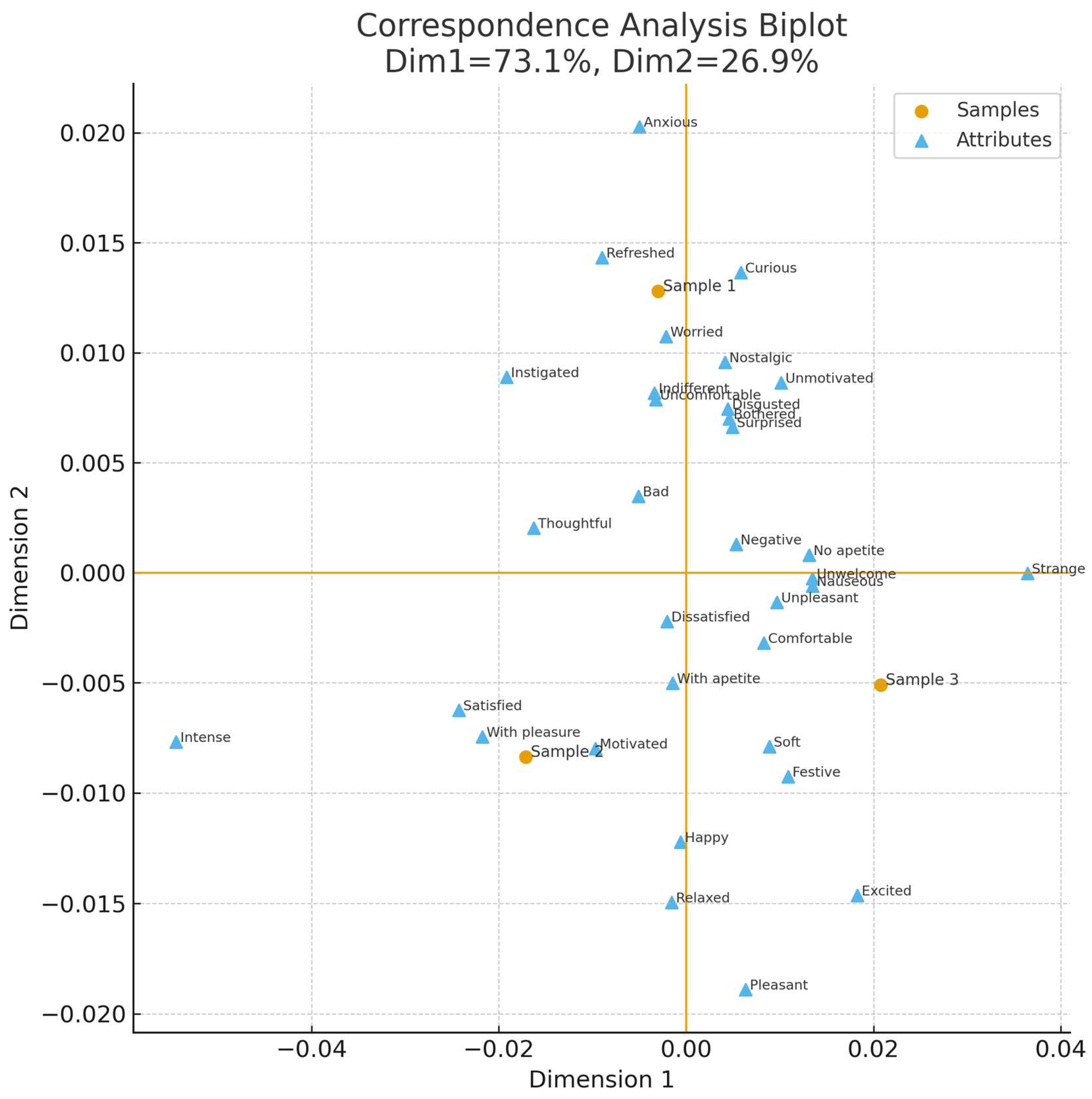

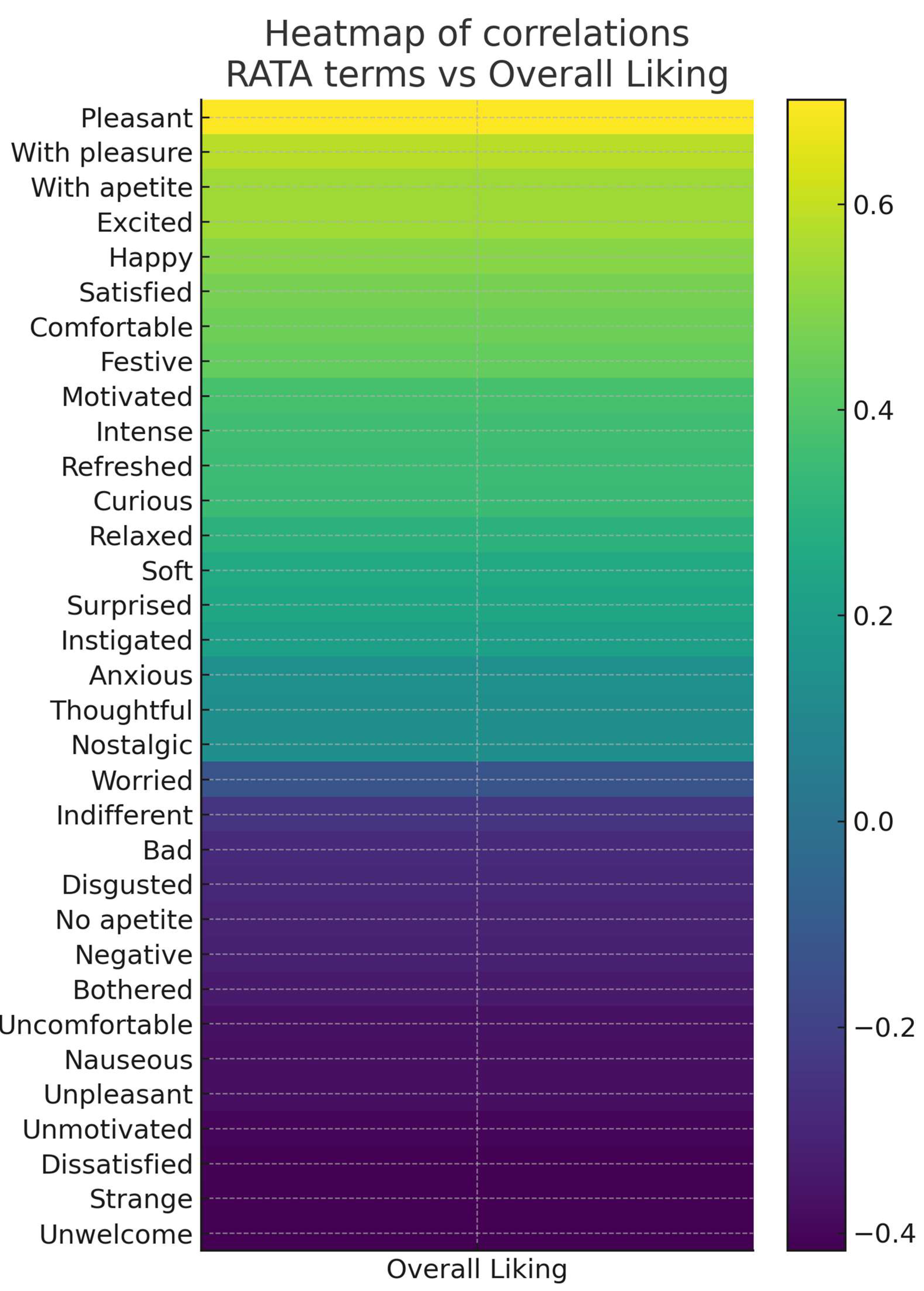

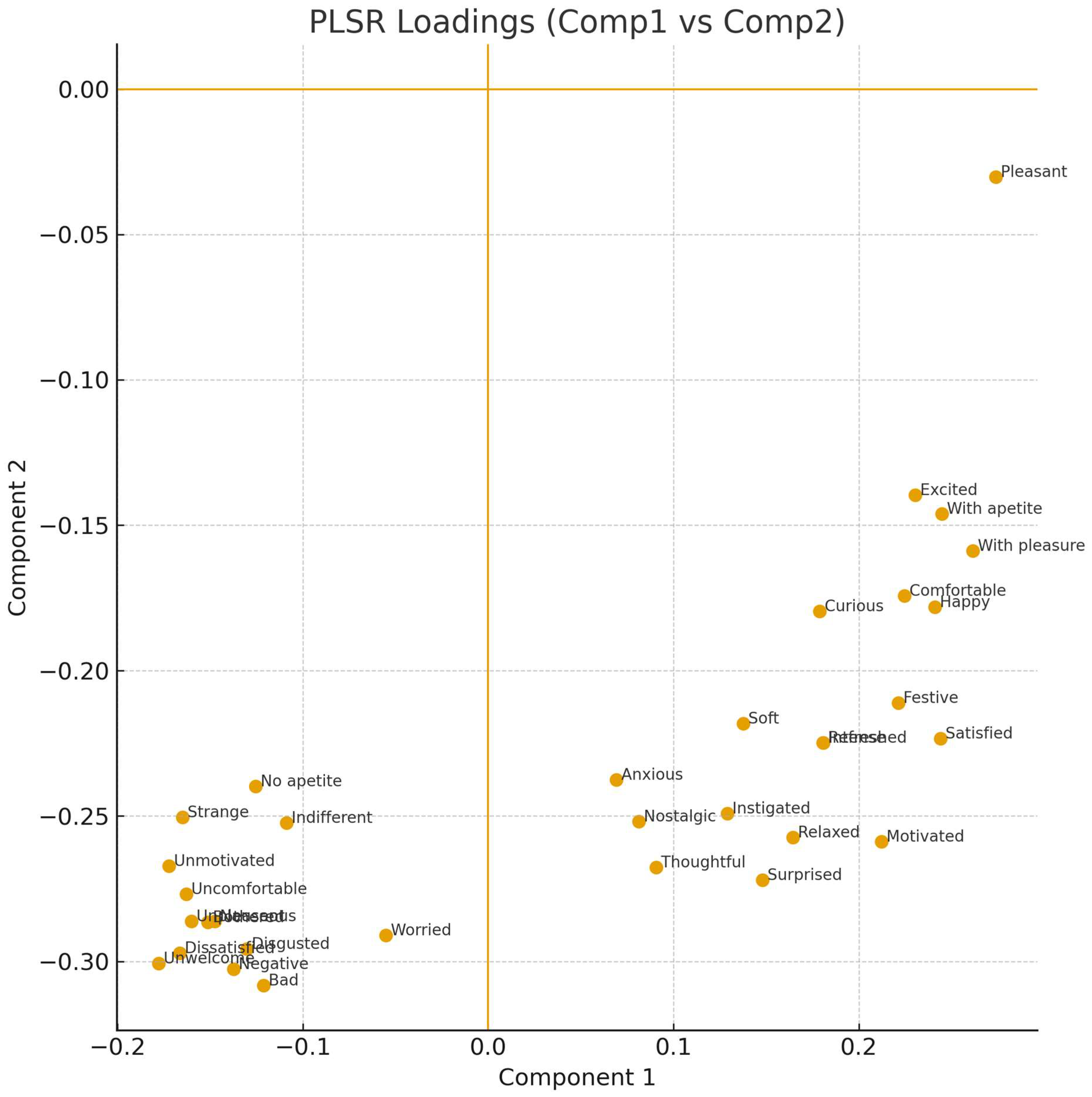


| Sample | Color | Plating | Composition |
|---|---|---|---|
| Sample 1 | Yellow | 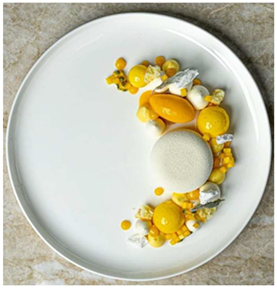 Chef’s Roll, Inc. [21] | Cream cheese mousse, vanilla whipped ganache, passion fruit cremeux, meringue, lemon madeleine sponge, passion fruit and mango ice cream, and banana cremeux. |
| Sample 2 | Red | 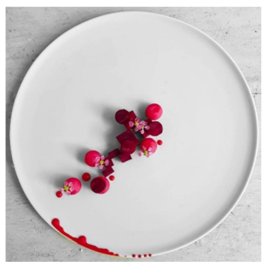 Chef Sijo Chandran [22] | Mini beetroot, truffled honey, goat cheese, and beetroot puree. |
| Sample 3 | Blue | 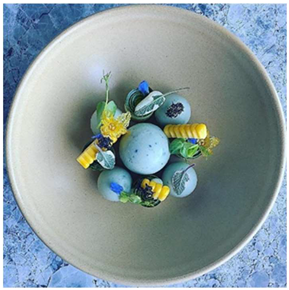 Mustafa Yankavi [23] | Blue cheese, inkfish sponge cake, coconut milk foam, cucumber flower, blue borage flower, micro pea shoots, and sage |
| Terms | Cochran’s Q (p-Values) | Sample 1 (Yellow) | Sample 2 (Red) | Sample 3 (Blue) |
|---|---|---|---|---|
| Anxious | <0.0001 | 0.790 b | 0.725 a | 0.705 a |
| Bad | 0.000 | 0.732 b | 0.698 a | 0.675 a |
| Bothered | 0.005 | 0.763 b | 0.715 a | 0.708 a |
| Comfortable | 0.101 | 0.854 a | 0.817 a | 0.814 a |
| Curious | <0.0001 | 0.922 b | 0.851 a | 0.847 a |
| Disgusted | 0.045 | 0.756 b | 0.715 a | 0.722 ab |
| Dissatisfied | 0.011 | 0.739 b | 0.712 ab | 0.692 a |
| Excited | 0.484 | 0.868 a | 0.844 a | 0.858 a |
| Festive | 0.292 | 0.831 a | 0.803 a | 0.803 a |
| Happy | 0.184 | 0.847 a | 0.834 a | 0.810 a |
| Indifferent | 0.002 | 0.763 b | 0.719 ab | 0.698 a |
| Instigated | <0.0001 | 0.817 b | 0.780 b | 0.729 a |
| Intense | <0.0001 | 0.810 b | 0.827 b | 0.705 a |
| Motivated | 0.016 | 0.783 b | 0.769 ab | 0.732 a |
| Nauseous | 0.001 | 0.753 b | 0.705 a | 0.698 a |
| Negative | 0.013 | 0.736 b | 0.698 ab | 0.692 a |
| No appetite | 0.053 | 0.780 b | 0.736 a | 0.742 ab |
| Nostalgic | 0.000 | 0.756 b | 0.705 a | 0.698 a |
| Pleasant | 0.417 | 0.953 a | 0.946 a | 0.932 a |
| Refreshed | 0.000 | 0.824 b | 0.769 a | 0.739 a |
| Relaxed | 0.147 | 0.756 a | 0.749 a | 0.725 a |
| Satisfied | 0.000 | 0.800 b | 0.793 b | 0.729 a |
| Soft | 0.246 | 0.800 a | 0.773 a | 0.769 a |
| Strange | 0.008 | 0.810 b | 0.749 a | 0.800 ab |
| Surprised | 0.003 | 0.824 b | 0.773 a | 0.766 a |
| Thoughtful | 0.001 | 0.810 b | 0.783 ab | 0.736 a |
| Uncomfortable | 0.004 | 0.769 b | 0.725 a | 0.705 a |
| Unmotivated | 0.003 | 0.769 b | 0.715 a | 0.719 a |
| Unpleasant | 0.060 | 0.763 a | 0.725 a | 0.725 a |
| Unwelcome | 0.035 | 0.746 b | 0.705 a | 0.712 ab |
| With appetite | 0.039 | 0.871 a | 0.844 a | 0.820 a |
| With pleasure | 0.001 | 0.854 b | 0.847 b | 0.783 a |
| Worried | <0.0001 | 0.739 b | 0.692 a | 0.675 a |
| Term | Sample 1 (Yellow) | Sample 2 (Red) | Sample 3 (Blue) | Friedman (p-Value) |
|---|---|---|---|---|
| Pleasant | 3.68 ± 1.37 a | 3.90 ± 1.35 a | 3.66 ± 1.54 a | 0.0229 |
| Excited | 3.18 ± 1.66 a | 3.23 ± 1.74 a | 3.11 ± 1.76 a | 0.6116 |
| Anxious | 1.78 ± 1.48 a | 1.69 ± 1.53 a | 1.59 ± 1.58 a | 0.0082 |
| With appetite | 2.65 ± 1.58 a | 2.66 ± 1.66 a | 2.49 ± 1.76 a | 0.0214 |
| With pleasure | 2.89 ± 1.67 a | 2.95 ± 1.70 a | 2.61 ± 1.86 a | 0.0056 |
| Nauseous | 1.19 ± 1.14 a | 1.01 ± 0.97 a | 1.14 ± 1.16 a | 0.0283 |
| Comfortable | 3.03 ± 1.64 a | 2.87 ± 1.75 a | 2.93 ± 1.84 a | 0.1775 |
| Curious | 3.62 ± 1.54 a | 3.39 ± 1.75 a | 3.36 ± 1.84 a | 0.0610 |
| Unpleasant | 1.13 ± 1.03 a | 1.07 ± 1.06 a | 1.09 ± 1.07 a | 0.3271 |
| Uncomfortable | 1.14 ± 1.05 a | 1.08 ± 1.08 a | 1.14 ± 1.17 a | 0.3515 |
| Unmotivated | 1.26 ± 1.20 a | 1.09 ± 1.15 a | 1.25 ± 1.27 a | 0.0045 |
| Disgusted | 1.14 ± 1.10 a | 0.97 ± 0.97 a | 1.03 ± 1.07 a | 0.0026 |
| Strange | 1.71 ± 1.43 a | 1.43 ± 1.36 b | 1.73 ± 1.50 a | 0.0003 |
| Happy | 3.05 ± 1.70 a | 3.03 ± 1.72 a | 2.84 ± 1.80 a | 0.0152 |
| Festive | 2.90 ± 1.79 a | 2.85 ± 1.85 a | 2.72 ± 1.83 a | 0.1697 |
| Bothered | 1.25 ± 1.19 a | 1.10 ± 1.10 a | 1.13 ± 1.12 a | 0.0340 |
| Unwelcome | 1.19 ± 1.18 a | 1.09 ± 1.14 a | 1.15 ± 1.22 a | 0.1204 |
| Indifferent | 1.33 ± 1.16 a | 1.11 ± 1.07 b | 1.16 ± 1.17 a | 0.0014 |
| Dissatisfied | 1.19 ± 1.18 a | 1.15 ± 1.19 a | 1.19 ± 1.27 a | 0.4148 |
| Instigated | 2.51 ± 1.71 a | 2.30 ± 1.79 a | 2.11 ± 1.82 b | 0.0007 |
| Intense | 2.56 ± 1.78 a | 2.92 ± 1.87 b | 2.01 ± 1.77 c | 0.0000 |
| Bad | 1.01 ± 0.90 a | 1.00 ± 1.01 a | 0.94 ± 0.97 a | 0.0112 |
| Motivated | 2.49 ± 1.78 a | 2.50 ± 1.78 a | 2.18 ± 1.82 a | 0.0034 |
| Negative | 1.07 ± 1.03 a | 0.99 ± 0.98 a | 1.11 ± 1.16 a | 0.1371 |
| Nostalgic | 1.41 ± 1.32 a | 1.25 ± 1.32 a | 1.49 ± 1.53 a | 0.0305 |
| Thoughtful | 2.27 ± 1.65 a | 2.17 ± 1.69 a | 2.25 ± 1.80 a | 0.5480 |
| Worried | 1.05 ± 0.99 a | 0.96 ± 0.96 a | 1.03 ± 1.10 a | 0.0928 |
| Refreshed | 2.43 ± 1.69 a | 2.14 ± 1.67 a | 2.24 ± 1.79 a | 0.0667 |
| Relaxed | 2.07 ± 1.65 a | 1.96 ± 1.64 a | 2.24 ± 1.84 a | 0.0331 |
| Satisfied | 2.59 ± 1.75 a | 2.62 ± 1.78 a | 2.39 ± 1.90 a | 0.2062 |
| No appetite | 1.59 ± 1.41 a | 1.34 ± 1.29 a | 1.50 ± 1.41 a | 0.0483 |
| Soft | 2.45 ± 1.67 a | 2.15 ± 1.69 a | 2.49 ± 1.84 a | 0.0296 |
| Surprised | 2.64 ± 1.72 a | 2.50 ± 1.83 a | 2.62 ± 1.86 a | 0.6313 |
| Sample | Means | Standard Error | Lower Limit (95%) | Upper Limit (95%) |
|---|---|---|---|---|
| Sample 1 (Yellow) | 6.820 b | 0.119 | 6.587 | 7.054 |
| Sample 2 (Red) | 7.275 a | 0.119 | 7.041 | 7.508 |
| Sample 3 (Blue) | 7.027 ab | 0.119 | 6.793 | 7.261 |
| Term | Pearson R | p-Value |
|---|---|---|
| Pleasant | 0.702 | 0.0 |
| With pleasure | 0.581 | 0.0 |
| With appetite | 0.542 | 0.0 |
| Excited | 0.540 | 0.0 |
| Happy | 0.505 | 0.0 |
| Satisfied | 0.472 | 0.0 |
| Comfortable | 0.453 | 0.0 |
| Festive | 0.438 | 0.0 |
| Unwelcome | −0.417 | 0.0 |
| Strange | −0.414 | 0.0 |
| Dissatisfied | −0.409 | 0.0 |
| Unmotivated | −0.403 | 0.0 |
| Motivated | 0.375 | 0.0 |
| Unpleasant | −0.373 | 0.0 |
| Nauseous | −0.372 | 0.0 |
| Uncomfortable | −0.368 | 0.0 |
| Intense | 0.359 | 0.0 |
| Refreshed | 0.352 | 0.0 |
| Curious | 0.346 | 0.0 |
| Bothered | −0.334 | 0.0 |
| Negative | −0.320 | 0.0 |
| No appetite | −0.310 | 0.0 |
| Relaxed | 0.300 | 0.0 |
| Disgusted | −0.293 | 0.0 |
| Bad | −0.283 | 0.0 |
| Soft | 0.261 | 0.0 |
| Indifferent | −0.249 | 0.0 |
| Surprised | 0.242 | 0.0 |
| Instigated | 0.214 | 0.0 |
| Anxious | 0.144 | 0.0 |
| Thoughtful | 0.142 | 0.0 |
| Nostalgic | 0.141 | 0.0 |
| Worried | −0.128 | 0.0001 |
| Term | Coefficient | VIP |
|---|---|---|
| Pleasant | 0.222 | 1.857 |
| With pleasure | 0.155 | 1.513 |
| Excited | 0.155 | 1.412 |
| With appetite | 0.144 | 1.411 |
| Happy | 0.123 | 1.316 |
| Satisfied | 0.100 | 1.244 |
| Comfortable | 0.104 | 1.187 |
| Festive | 0.097 | 1.149 |
| Strange | −0.128 | 1.092 |
| Unwelcome | −0.120 | 1.090 |
| Dissatisfied | −0.124 | 1.074 |
| Unmotivated | −0.115 | 1.053 |
| Motivated | 0.064 | 1.016 |
| Nauseous | −0.116 | 0.981 |
| Unpleasant | −0.106 | 0.974 |
| Uncomfortable | −0.100 | 0.959 |
| Intense | 0.080 | 0.941 |
| Refreshed | 0.075 | 0.927 |
| Curious | 0.073 | 0.911 |
| Bothered | −0.089 | 0.871 |
| Negative | −0.091 | 0.835 |
| No appetite | −0.094 | 0.815 |
| Relaxed | 0.056 | 0.803 |
| Disgusted | −0.080 | 0.765 |
| Bad | −0.081 | 0.741 |
| Soft | 0.053 | 0.690 |
| Surprised | 0.032 | 0.681 |
| Indifferent | −0.069 | 0.650 |
| Instigated | 0.030 | 0.597 |
| Thoughtful | 0.016 | 0.411 |
| Nostalgic | 0.023 | 0.385 |
| Anxious | 0.035 | 0.375 |
| Worried | −0.036 | 0.335 |
| Question/Sample | Sample 1 (Yellow) | Sample 2 (Red) | Sample 3 (Blue) |
|---|---|---|---|
| Do you like the main color present in the sample? | 3.979 b ± 0.057 | 4.217 a ± 0.054 | 4.264 a ± 0.058 |
| Did the plates used influence emotional perception? | 3.964 b ± 0.059 | 4.251 a ± 0.060 | 4.270 a ± 0.059 |
| Did the shapes and arrangements influence the perception of emotions? | 4.158 b ± 0.046 | 4.317 a ± 0.046 | 4.382 a ± 0.047 |
| Attributes | Cochran’s Q (p-Values) | Sample 1 (Yellow) | Sample 2 (Red) | Sample 3 (Blue) |
|---|---|---|---|---|
| Sweet | <0.0001 | 0.556 a | 0.603a | 0.776 b |
| Salty | <0.0001 | 0.349 b | 0.244ab | 0.180 a |
| Bitter | 0.0000 | 0.078 a | 0.193b | 0.129 ab |
| Sour | <0.0001 | 0.525 c | 0.315b | 0.142 a |
| Umami | 0.6070 | 0.122 a | 0.132a | 0.105 a |
| Fatty | <0.0001 | 0.397 c | 0.027a | 0.224 b |
| Astringent | 0.6530 | 0.186 a | 0.207a | 0.176 a |
| Spicy | <0.0001 | 0.058 a | 0.298b | 0.068 a |
Disclaimer/Publisher’s Note: The statements, opinions and data contained in all publications are solely those of the individual author(s) and contributor(s) and not of MDPI and/or the editor(s). MDPI and/or the editor(s) disclaim responsibility for any injury to people or property resulting from any ideas, methods, instructions or products referred to in the content. |
© 2025 by the authors. Licensee MDPI, Basel, Switzerland. This article is an open access article distributed under the terms and conditions of the Creative Commons Attribution (CC BY) license (https://creativecommons.org/licenses/by/4.0/).
Share and Cite
Silva, J.; Lima, F.E.; Souza, C.; Moreira-Leite, B.; Sousa, P. The Influence of Food Colors on Emotional Perception and Consumer Acceptance: A Sensory and Emotional Profiling Approach in Gastronomy. Foods 2025, 14, 3818. https://doi.org/10.3390/foods14223818
Silva J, Lima FE, Souza C, Moreira-Leite B, Sousa P. The Influence of Food Colors on Emotional Perception and Consumer Acceptance: A Sensory and Emotional Profiling Approach in Gastronomy. Foods. 2025; 14(22):3818. https://doi.org/10.3390/foods14223818
Chicago/Turabian StyleSilva, Jarbas, Francisca Elisângela Lima, Clarisse Souza, Bruno Moreira-Leite, and Paulo Sousa. 2025. "The Influence of Food Colors on Emotional Perception and Consumer Acceptance: A Sensory and Emotional Profiling Approach in Gastronomy" Foods 14, no. 22: 3818. https://doi.org/10.3390/foods14223818
APA StyleSilva, J., Lima, F. E., Souza, C., Moreira-Leite, B., & Sousa, P. (2025). The Influence of Food Colors on Emotional Perception and Consumer Acceptance: A Sensory and Emotional Profiling Approach in Gastronomy. Foods, 14(22), 3818. https://doi.org/10.3390/foods14223818






